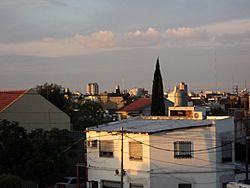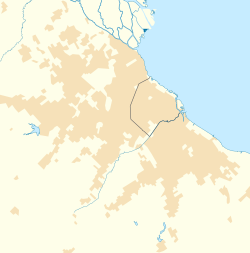San Justo, Buenos Aires facts for kids
Quick facts for kids
San Justo
|
|
|---|---|

View towards the city centre of San Justo from the residential area
|
|
| Country | |
| Province | |
| Partido | |
| Founded | December 25, 1856 |
| Elevation | 26 m (85 ft) |
| Population
(2001 census [INDEC])
|
|
| • Total | 105,274 |
| • Density | 6,958/km2 (18,020/sq mi) |
| CPA Base |
B 1754
|
| Area code(s) | +54 11 |
San Justo is a city in Argentina. It is the main city of an area called La Matanza Partido, located in Buenos Aires Province.
It is a busy city with many shops, businesses, and cultural places. Its location near important highways, like National Highway 3 and Provincial Highway 4, helps make it very active.
A famous Argentine poet, Pedro Bonifacio Palacios, was born here. One of the city's main streets is named after him, using his nickname Almafuerte.
The heart of San Justo is Plaza San Martín. This square is the center of the La Matanza area. Many important government buildings are located around it.
Contents
History of San Justo
The idea to create a main city in La Matanza started in 1852. A judge named Lino Lagos first asked for land for this purpose. However, the land was not officially given until 1856.
José Gorchs, who represented the family of Justo Villegas, offered to donate their land. They wanted to build a town hall, a church, a school, and a police station there. The donated land also included space for a cemetery, a market, and homes.
On December 25, 1856, the city was officially founded. It was built on land from Justo Villegas, a well-known landowner. His family asked for the city to be named San Justo in his honor.
Melchor Romero was in charge of planning the village. His plan was approved in 1857. The city center was designed in the old Spanish Colonial style. It had a park in the middle, with the town hall, church, bank, and police station on each side.
In the early days, the economy of San Justo was mostly based on farming and raising animals. Growing grains was very important. After 1852, cattle farming changed to sheep farming, which was popular until the late 1800s.
City Life and Economy
San Justo became an important industrial area in the 1940s and 1950s. Many factories were built here. However, after 1980, the city lost many of its industries.
Some areas had empty lots and informal settlements. But now, the city is working to improve housing. More businesses are also returning, which helps the city grow.
Some big companies in San Justo include a steel mill called Acindar. There is also Eternit, which makes building materials. Papelera Tucumán is a paper mill. A large machinery factory, once Siam di Tella, was bought by the Pérez Companc Group in 1986.
The city has continued to grow. Most of its 36,000 households live in middle-class neighborhoods. Less than 20% of people live in less formal housing.
Education in San Justo
San Justo has many schools for all ages. There are primary schools, secondary schools, and universities.
Two well-known schools are the "Almafuerte" School, which is a public school that has won awards, and the San Justo Parochial School.
The National University of La Matanza is also located in San Justo. It is a major place for learning, sports, and cultural activities in the area.
Notable People from San Justo
- Sebastián Driussi (born 1996), a football player
- Pedro Bonifacio Palacios (1854-1917), a famous poet
- Lidia Elsa Satragno (born 1935), an entertainer and politician
- Franco Paredes (born 1999), a football player
- Leandro Paredes (born 1994), a football player
See also
 In Spanish: San Justo (Buenos Aires) para niños
In Spanish: San Justo (Buenos Aires) para niños






